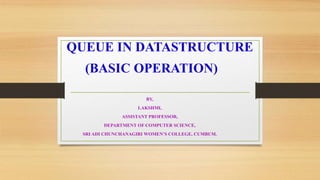Basic Queue Operation in DataStructure.pptx
•Télécharger en tant que PPTX, PDF•
0 j'aime•98 vues
This PPT has Basic Queue Operation
Signaler
Partager
Signaler
Partager

Recommandé
Contenu connexe
Tendances
Tendances (20)
Similaire à Basic Queue Operation in DataStructure.pptx
Similaire à Basic Queue Operation in DataStructure.pptx (20)
Plus de LakshmiSamivel
Plus de LakshmiSamivel (13)
Dernier
https://app.box.com/s/tkvuef7ygq0mecwlj72eucr4g9d3ljcs50 ĐỀ LUYỆN THI IOE LỚP 9 - NĂM HỌC 2022-2023 (CÓ LINK HÌNH, FILE AUDIO VÀ ĐÁ...

50 ĐỀ LUYỆN THI IOE LỚP 9 - NĂM HỌC 2022-2023 (CÓ LINK HÌNH, FILE AUDIO VÀ ĐÁ...Nguyen Thanh Tu Collection
Dernier (20)
MARUTI SUZUKI- A Successful Joint Venture in India.pptx

MARUTI SUZUKI- A Successful Joint Venture in India.pptx
Industrial Training Report- AKTU Industrial Training Report

Industrial Training Report- AKTU Industrial Training Report
50 ĐỀ LUYỆN THI IOE LỚP 9 - NĂM HỌC 2022-2023 (CÓ LINK HÌNH, FILE AUDIO VÀ ĐÁ...

50 ĐỀ LUYỆN THI IOE LỚP 9 - NĂM HỌC 2022-2023 (CÓ LINK HÌNH, FILE AUDIO VÀ ĐÁ...
1.4 modern child centered education - mahatma gandhi-2.pptx

1.4 modern child centered education - mahatma gandhi-2.pptx
Students, digital devices and success - Andreas Schleicher - 27 May 2024..pptx

Students, digital devices and success - Andreas Schleicher - 27 May 2024..pptx
The Art Pastor's Guide to Sabbath | Steve Thomason

The Art Pastor's Guide to Sabbath | Steve Thomason
Benefits and Challenges of Using Open Educational Resources

Benefits and Challenges of Using Open Educational Resources
plant breeding methods in asexually or clonally propagated crops

plant breeding methods in asexually or clonally propagated crops
Basic Queue Operation in DataStructure.pptx
- 1. QUEUE IN DATASTRUCTURE (BASIC OPERATION) BY, LAKSHMI, ASSISTANT PROFESSOR, DEPARTMENT OF COMPUTER SCIENCE, SRI ADI CHUNCHANAGIRI WOMEN’S COLLEGE, CUMBUM.
- 2. What is a Queue? 1. A queue can be defined as an ordered list which enables insert operations to be performed at one end called REAR and delete operations to be performed at another end called FRONT. • 2. Queue is referred to be as First In First Out list. • 3. For example, people waiting in line for a rail ticket form a queue.
- 4. Applications of Queue • Queues are widely used as waiting lists for a single shared resource like printer, disk, CPU. • Queues are used in asynchronous transfer of data (where data is not being transferred at the same rate between two processes) for eg. pipes, file IO, sockets. • Queues are used as buffers in most of the applications like MP3 media player, CD player, etc. • Queue are used to maintain the play list in media players in order to add and remove the songs from the play-list. • Queues are used in operating systems for handling interrupts.
- 5. Complexity Data Structu re Time Complexity Space Compl eity Average Worst Worst Access Search Insertio n Deletio n Access Search Insertio n Deletio n Queue θ(n) θ(n) θ(1) θ(1) O(n) O(n) O(1) O(1) O(n)
- 6. Basic Operations for Queue in Data Structure A queue is an object (an abstract data structure - ADT) that allows the following operations: • Enqueue: Add an element to the end of the queue • Dequeue: Remove an element from the front of the queue • IsEmpty: Check if the queue is empty • IsFull: Check if the queue is full • Peek: Get the value of the front of the queue without removing it
- 7. Enqueue() Operation The following steps should be followed to insert (enqueue) data element into a queue - • Step 1: Check if the queue is full. • Step 2: If the queue is full, Overflow error. • Step 3: If the queue is not full, increment the rear pointer to point to the next available empty space. • Step 4: Add the data element to the queue location where the rear is pointing. • Step 5: Here, you have successfully added 7, 2, and -9.
- 9. Dequeue() Operation Obtaining data from the queue comprises two subtasks: access the data where the front is pointing and remove the data after access. You should take the following steps to remove data from the queue - • Step 1: Check if the queue is empty. • Step 2: If the queue is empty, Underflow error. • Step 3: If the queue is not empty, access the data where the front pointer is pointing. • Step 4: Increment front pointer to point to the next available data element. • Step 5: Here, you have removed 7, 2, and -9 from the queue data structure.
- 11. Peek() Operation This function helps in extracting the data element where the front is pointing without removing it from the queue. The algorithm of Peek() function is as follows- • Step 1: Check if the queue is empty. • Step 2: If the queue is empty, return “Queue is Empty.” • Step 3: If the queue is not empty, access the data where the front pointer is pointing. • Step 4: Return data.
- 12. isFull() Operation This function checks if the rear pointer is reached at MAXSIZE to determine that the queue is full. The following steps are performed in the isFull() operation - • Step 1: Check if rear == MAXSIZE - 1. • Step 2: If they are equal, return “Queue is Full.” • Step 3: If they are not equal, return “Queue is not Full.”
- 13. isNull() Operation The algorithm of the isNull() operation is as follows - • Step 1: Check if the rear and front are pointing to null memory space, i.e., -1. • Step 2: If they are pointing to -1, return “Queue is empty.” • Step 3: If they are not equal, return “Queue is not empty.”